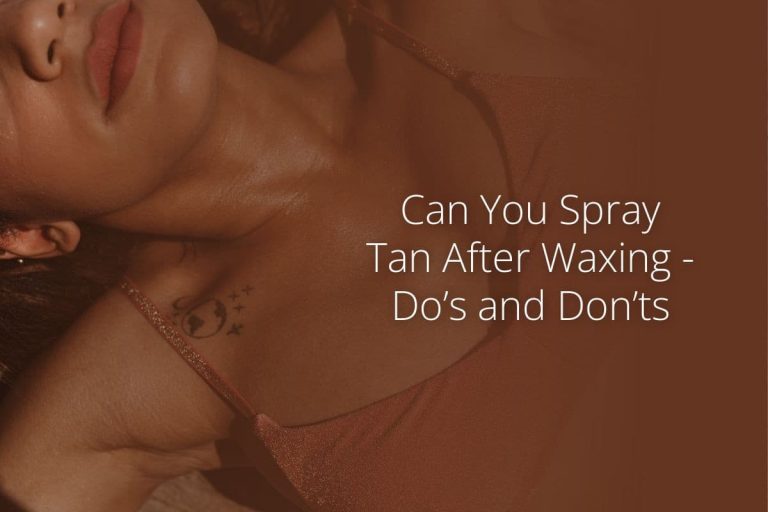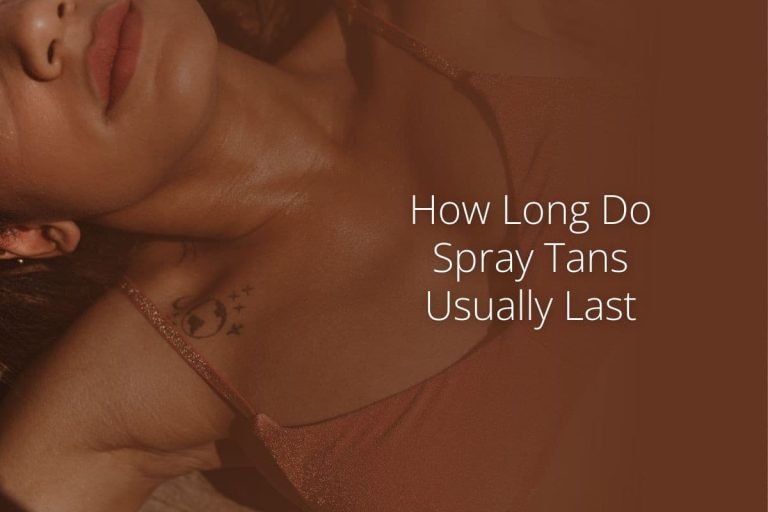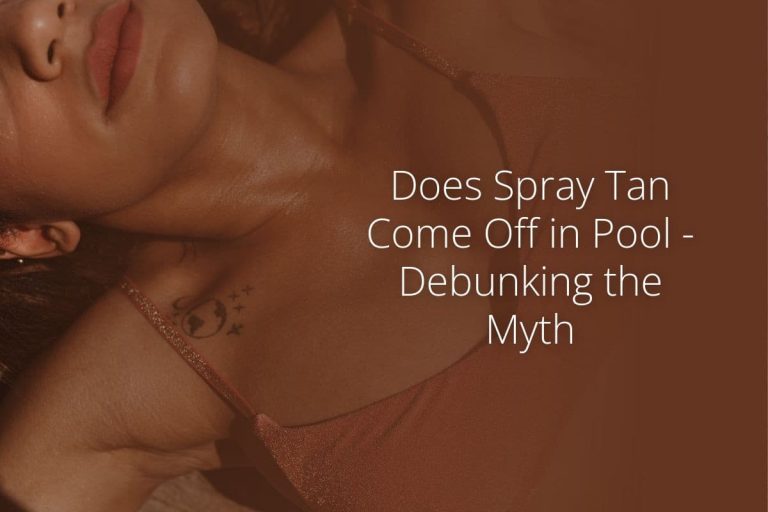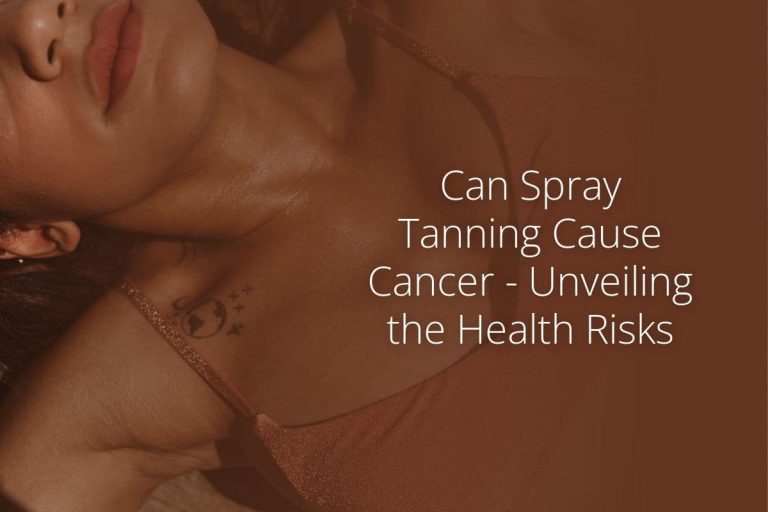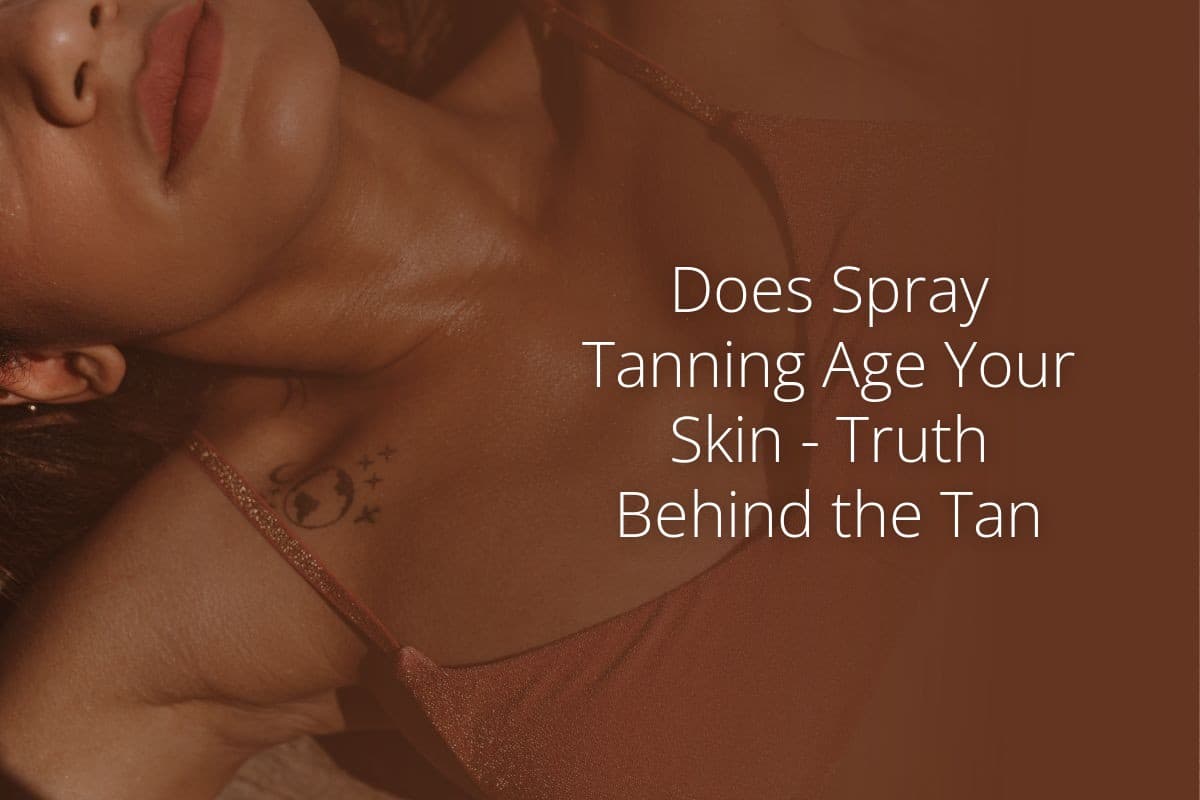
Have you ever wondered if using fake tans or sunless tanners can actually accelerate the aging process of your skin? Spray tanning is a popular method to achieve a bronzed look, but it’s important to consider the potential impact on your skin, such as age spots. With sunless tanners, such as spray tanning, being a popular choice for achieving that sun-kissed glow without harmful UV exposure, it’s important to understand their potential effects on skin aging and age spots.
Spray tanning does not inherently age your skin. The solution used in spray tans primarily contains an ingredient called Dihydroxyacetone (DHA), which interacts with the dead surface cells in the skin to temporarily darken its appearance. This process is significantly different from traditional tanning, which involves UV radiation that can damage skin cells and accelerate aging. However, it’s important to note that while spray tanning itself doesn’t age the skin, improper skincare before and after the process can lead to dryness, which could potentially contribute to the appearance of premature aging.
Having said that, it’s worth noting that there’s more to the story than just the immediate effects of spray tanning. Other factors involved in the process, such as the quality of the tanning solution, your skin type, and how well you maintain your skin post-tan, can all play a role in how your skin reacts to spray tanning. Also, while spray tanning is a safer alternative to sunbathing or tanning beds when it comes to skin aging, it is not a skincare treatment. It is still essential to follow proper skincare routines to maintain healthy and youthful skin. So, stick around if you’re interested in learning more about how to take care of your skin before and after a spray tan, and other tips for maintaining a healthy glow without compromising your skin health.
Safety of Spray Tans for Youthful Skin
Spray tans are generally safe to use for achieving a tanner complexion and minimizing spots on the legs, resulting in youthful-looking skin. The active ingredient in most self-tanners, DHA, has been approved by regulatory bodies for use on spots. Proper application techniques and quality fake tan products can minimize any potential risks to your skin. Make sure to use the tanner correctly to avoid spots. Regular moisturizing after spray tanning helps maintain healthy and hydrated skin, especially for tanner spots. It is important to use moisturizers to keep the skin nourished and prevent dryness.
- Sunless tanning products, such as sunless tanners, are a safer alternative to traditional sunbathing or tanning beds for avoiding spots.
- The main ingredient in most self-tanners is DHA (dihydroxyacetone), which has been deemed safe by regulatory authorities. Self-tanners are effective in giving the skin an even tan without the need for sun exposure, reducing the appearance of spots. Self-tanners are effective in giving the skin an even tan without the need for sun exposure, reducing the appearance of spots. Self-tanners are effective in giving the skin an even tan without the need for sun exposure, reducing the appearance of spots.
- When using sunless tan products, it’s important to follow the instructions carefully for optimal tanner results and safety. Avoid applying too much product to prevent dark spots.
- Prior to applying the fake tan, exfoliating your skin can help create an even base and prevent spots, streaks or patches.
- To protect your skin from harmful UV rays and prevent spots, it’s still essential to wear sunscreen even if you have a sunless tan.
- Quality spray tan solutions that contain natural ingredients can be gentler on the skin compared to harsher alternatives.
- Moisturizing regularly after spray tanning helps maintain the longevity of your tan and keeps your skin hydrated.
- Avoid excessive exposure to chlorinated water or hot showers immediately after getting a spray tan as they may affect its longevity.
- If you have sensitive skin or any concerns about allergies, it’s advisable to do a patch test before applying the fake tan product all over.
Negative Effects of Self-Tanners on Skin Aging
Using self-tanners can have negative effects on the aging process of your skin. Here are some important points to consider:
- Some self-tanners may contain additional ingredients that could potentially harm the skin’s elasticity. It’s crucial to be aware of these side effects when choosing a self-tanner.
- Overuse or improper application of self-tanners can result in an unnatural appearance that can make you look older than you actually are. It is crucial to follow the instructions carefully when applying fake tan and ensure that the product is distributed evenly.
- Excessive exfoliation before applying self-tanner can lead to dryness and premature aging of the skin. It is recommended to exfoliate gently and moisturize adequately before using any self-tanning products.
- To minimize the negative effects on your skin, it’s important to choose reputable brands with high-quality ingredients. Researching and selecting trusted fake tan brands will help ensure a safer experience.
Remember, while self-tanners offer a convenient way to achieve a sun-kissed glow, it’s crucial to use them responsibly and take care of your skin during the process.
Assessing Risks: Fake Tan Products and Skin Safety
Fake tan products, including sprays, lotions, and mousses, undergo safety assessments by regulatory agencies. These assessments ensure that the products meet certain standards and do not pose significant risks to the skin.
Allergic reactions or irritation from fake tan products are possible but relatively rare occurrences. It’s important to note that individual reactions may vary, and what works for one person might not work for another. However, most people can use fake tanning products without experiencing any adverse effects.
To minimize the risk of adverse reactions with fake tan, it is recommended to patch test new products before applying them all over the body. This involves applying a small amount of fake tan on a small area of skin and waiting for any negative reactions to occur. By doing so, you can identify any potential allergies or sensitivities before fully committing to using the fake tan product.
Following proper usage instructions is crucial in reducing risks associated with fake tanning. It is crucial to carefully read and follow the manufacturer’s directions for applying and maintaining a fake tan. Avoiding contact with sensitive areas such as eyes, lips, and open wounds can further reduce the chances of adverse effects.
While some concerns have been raised about additives used in fake tans and DHA exposure (the active ingredient responsible for color development), current research suggests that when used as directed, these risks are minimal.
Unveiling the Mystery: Persistent Tan Marks and Aging
Persistent tan marks caused by spray tanning do not accelerate the natural aging process of your skin cells. These marks are temporary and fade as your skin naturally sheds dead cells. Regular exfoliation can help speed up the fading process of tan marks. Protecting your skin from excessive sun exposure can prevent new tan marks from forming.
- Tan Marks Are Temporary: Contrary to popular belief, spray tanning does not age your skin. The darkening effect is only temporary and will gradually fade away as your body sheds dead skin cells.
- Exfoliation Speeds Up Fading: To expedite the disappearance of tan marks, make sure to exfoliate regularly. By gently scrubbing away the top layers of dead skin cells, you promote a faster turnover, revealing fresher and lighter-looking skin.
- Sun Protection Prevents New Marks: Shielding your skin from harmful UV rays is crucial in preventing new tan marks from appearing. Applying sunscreen with adequate SPF and wearing protective clothing will safeguard vulnerable areas from further darkening.
- Avoid Clogged Pores: Spray tanning products may sometimes contribute to clogged pores, leading to potential breakouts or blemishes. To avoid this issue, ensure proper cleansing of your skin before and after spray tanning sessions.
- No Impact on Wrinkles or Age Spots: While spray tanning may darken certain areas temporarily, it has no direct impact on wrinkles or age spots. These signs of aging are primarily influenced by factors such as genetics, sun exposure over time, and collagen depletion.
The Verdict on Spray Tanning and Skin Aging
So, does spray tanning age your skin? After exploring the safety of spray tans for youthful skin, discussing the negative effects of self-tanners on skin aging, assessing the risks associated with fake tan products and skin safety, and unveiling the mystery behind persistent tan marks and aging, it’s time to reveal the verdict.
While spray tanning itself doesn’t directly accelerate the aging process, certain factors surrounding its application can have an impact. It’s crucial to prioritize your skin’s health by opting for high-quality products and following proper preparation and aftercare routines. Remember, moderation is key! If you’re considering a spray tan to achieve that sun-kissed glow without damaging your skin under harmful UV rays, go ahead and enjoy it responsibly.
Now that you have a clearer understanding of spray tanning and its effects on skin aging, it’s time to take action. Embrace safe practices when using self-tanners or seeking professional spray tan services. Protect your skin from premature aging while still achieving that beautiful bronzed look you desire. Your skin will thank you!
FAQs about Spray Tanning:
Can I apply sunscreen over my spray tan?
Yes, absolutely! While sunscreen should ideally be applied before getting a spray tan to protect your natural complexion, you can still apply sunscreen over your spray tan without any issues. Just make sure to use a broad-spectrum sunscreen with SPF 30 or higher to shield your skin from harmful UV rays.
How long does a spray tan typically last?
The longevity of a spray tan depends on various factors such as your skincare routine, lifestyle choices, and how well you follow aftercare instructions. On average, a spray tan can last anywhere from 5-10 days. Regularly moisturizing your skin can help prolong its lifespan.
Will a spray tan protect me from sunburn?
No, unfortunately not. A spray tan does not provide any protection against sunburn. It’s essential to continue using sunscreen and taking necessary precautions when exposing your skin to the sun, even if you have a spray tan.
Can pregnant women get a spray tan?
While the active ingredients in most self-tanners are generally considered safe for pregnant women, it’s always best to consult with your healthcare provider before getting a spray tan during pregnancy. They can provide personalized advice based on your specific situation.
Is it possible to achieve a natural-looking tan with a spray tan?
Yes, absolutely! With advancements in spray tanning technology and techniques, professional technicians can create natural-looking tans that suit your skin tone and desired level of bronzing. Just communicate your preferences clearly and trust their expertise.

